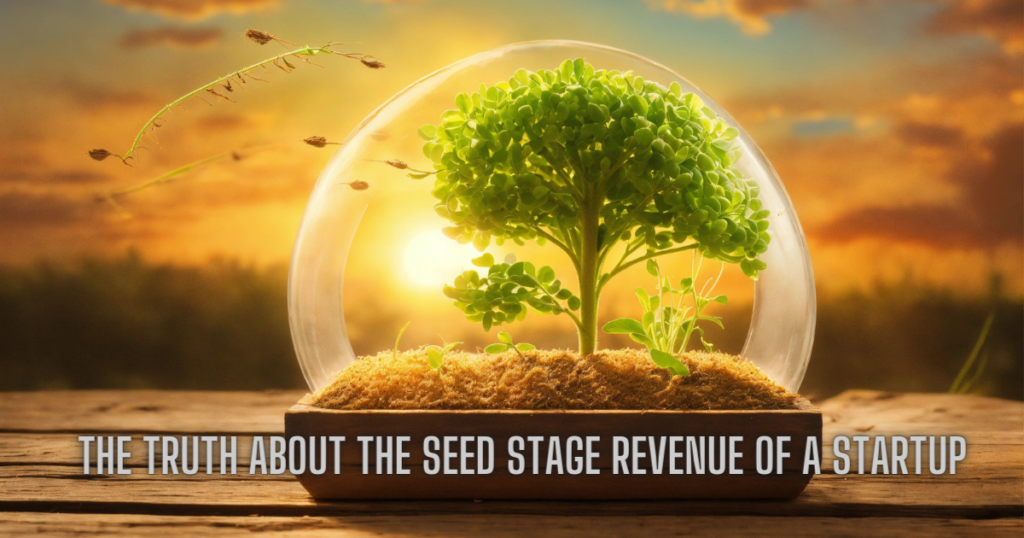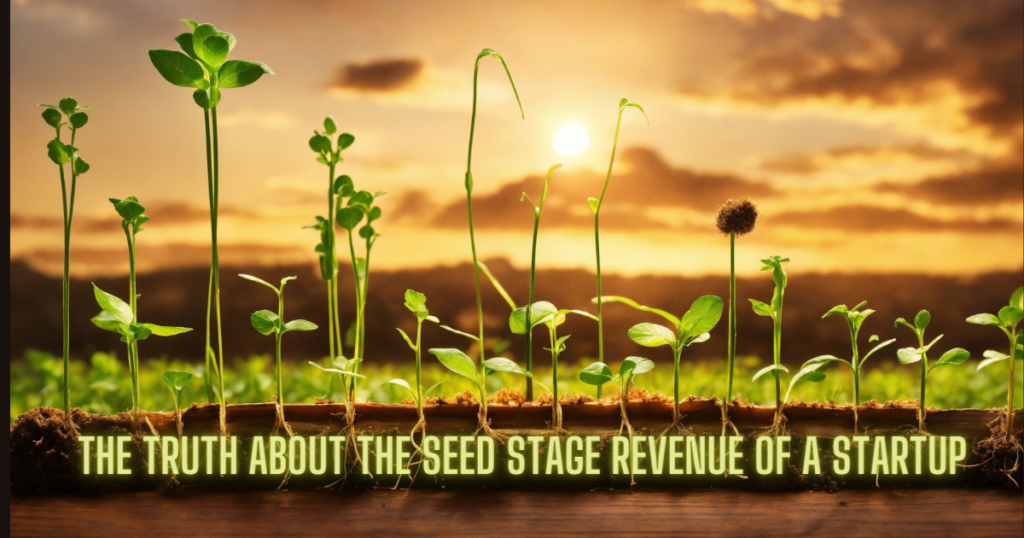Introduction
The seed stage symbolizes the birth of a startup, injecting initial capital when the concept is predominantly an idea with minimal or no revenue. However, it’s imperative to note that not all startups remain devoid of revenue during this phase; some may exhibit revenue streams, contingent on the business’s nature, product, and market dynamics. This exploration delves into the essence of the Seed Stage Revenue, its goals, funding mechanisms, challenges, outcomes, and why certain startups may not accrue revenue during this pivotal stage.

Dispelling the Myth: Seed Stage Revenue
- Reasons Behind a Lack of Seed Stage Revenue
- Understanding the Seed Stage-Seed Stage Revenue
- Conclusion
- People also ask-Seed Stage Revenue
- Disclaimer
Contrary to popular belief, the seed stage does not universally equate to a lack of revenue. The reality varies among startups; some generate revenue, while others do not. This variability hinges on factors such as the business model, the product’s nature, and the characteristics of the target market.
Reasons Behind a Lack of Seed Stage Revenue
For startups navigating the seed stage without revenue, several factors may contribute to this scenario:
- MVP Development Focus:
- The startup prioritizes crafting a Minimum Viable Product (MVP) aimed at solving a genuine problem before launching or testing it with customers.
- Competitive or Regulated Market Environment:
- Operating in highly competitive or regulated markets may necessitate extensive investment in research, development, and compliance before revenue generation becomes feasible.
- Pursuit of Innovative Business Models:
- Startups pursuing disruptive or innovative business models may prioritize educating the market and creating demand before transitioning to revenue generation.
- Emphasis on Long-term Impact:
- Some startups aim for large-scale or long-term impact, prioritizing user acquisition and retention over immediate revenue generation in the early stages.
While lacking revenue in the seed stage, these startups contribute value and demonstrate progress through alternative indicators such as user feedback, product usage, partnerships, and social impact. These factors play a pivotal role in attracting investors and customers, setting the stage for future revenue generation.

Understanding the Seed Stage-Seed Stage Revenue
What is the Seed Stage of a Startup?
The seed stage marks the initial infusion of capital into a business, typically characterized by the formation of the idea. During this phase, a startup is in the early stages of developing its product and go-to-market strategy.
Goals of the Seed Stage
The primary objectives during the seed stage include validating the problem-solution fit, finding the product-market fit, and achieving key traction or growth indicators. These goals serve to showcase the startup’s potential and viability to prospective investors and customers.
Funding the Seed Stage
Funding for the seed stage predominantly comes from founders, friends and family, angel investors, or pre-seed funds. The funding amount varies based on industry, market dynamics, and the specific needs of the startup. In return, investors typically receive equity or convertible notes in the startup.
Challenges of the Seed Stage
Navigating the seed stage presents numerous challenges, including finding the right co-founders and team members, building a compelling MVP, testing and iterating based on customer feedback, determining optimal pricing and business models, acquiring and retaining initial customers, managing cash flow, and pitching for the next round of funding.
Outcomes of the Seed Stage
Outcomes at the end of the seed stage can vary significantly, depending on the startup’s performance and progress. Potential outcomes encompass achieving product-market fit, traction, and growth, leading to a Series A funding round. Alternatively, a startup may pivot to address different challenges, run out of funding and shut down, or become acquired by another company.
Conclusion
The seed stage represents one of the most challenging and precarious phases in a startup’s life cycle. It involves validating the problem-solution fit, finding the product-market fit, and achieving key traction indicators. Funding for the seed stage typically comes from founders, friends and family, angel investors, or pre-seed funds. Outcomes can be positive or negative based on the startup’s performance, with revenue presence or absence influenced by various factors.
Common reasons for a lack of revenue in the seed stage include a focus on building an MVP, operating in competitive or regulated markets, pursuing innovative business models, or prioritizing long-term impact over immediate revenue. In essence, the seed stage is a complex journey where startups lay the foundation for future growth and success, navigating challenges, and making strategic decisions to shape their entrepreneurial destiny.
People also ask-Seed Stage Revenue
- What is the revenue of a seed stage startup?
- The revenue of a seed stage startup can vary widely depending on the industry, business model, and market conditions. Seed stage startups typically have limited revenue, often ranging from zero to a few hundred thousand dollars. The focus during this phase is more on validating the business concept and gaining traction rather than generating substantial revenue.
- What is the valuation of a startup at the seed stage?
- Valuation at the seed stage is influenced by factors like the startup’s potential, market opportunity, team expertise, and product uniqueness. Seed stage valuations commonly fall in the range of $1 million to $5 million, but this can fluctuate based on various circumstances and investor perceptions.
- How much revenue do you need for seed?
- There’s no fixed revenue requirement for seed funding as it primarily depends on the startup’s industry, business model, and growth potential. Seed funding is more about proving the concept and demonstrating market traction than hitting a specific revenue threshold. Startups often secure seed funding with minimal or no revenue, focusing on their potential for future growth.
- What is the success rate of seed funding?
- The success rate of seed funding varies, and success is not solely measured by the amount raised. Success in seed funding is more about achieving key milestones, gaining investor confidence, and setting the stage for future funding rounds. While success rates can fluctuate, startups that effectively execute their plans, demonstrate traction, and meet investor expectations increase their chances of securing subsequent funding rounds. Success is a nuanced concept that goes beyond mere funding and includes factors like product-market fit, growth trajectory, and market adaptability.
Disclaimer
This article has been created on the basis of internal data, information available publicly, and other reliable sources to be believed. The article may also include information which are the personal views/opinions of the authors. The information included in this article is for general, educational, and awareness purposes only and is not a full disclosure of every material fact.
All the information on this website i.e. World Virtual CFO – is published in good faith and for general information purposes only. World Virtual CFO does not make any warranties about the completeness, reliability, and accuracy of this information. These are my views for only information purposes. Any action you take upon the information you find on this website (World Virtual CFO), is strictly at your own risk. World Virtual CFO will not be liable for any losses and/or damages in connection with using our website. For details please refer to our disclaimer page.
Dr. Dinesh Sharma is an award-winning CFO and AI strategist with over two decades of experience in financial leadership, digital transformation, and business optimization. As the founder of multiple niche platforms—including WorldVirtualCFO.com—he empowers professionals and organizations with strategic insights, system structuring, and innovative tools for sustainable growth. His blogs and e-books blend precision with vision, making complex financial and technological concepts accessible and actionable.